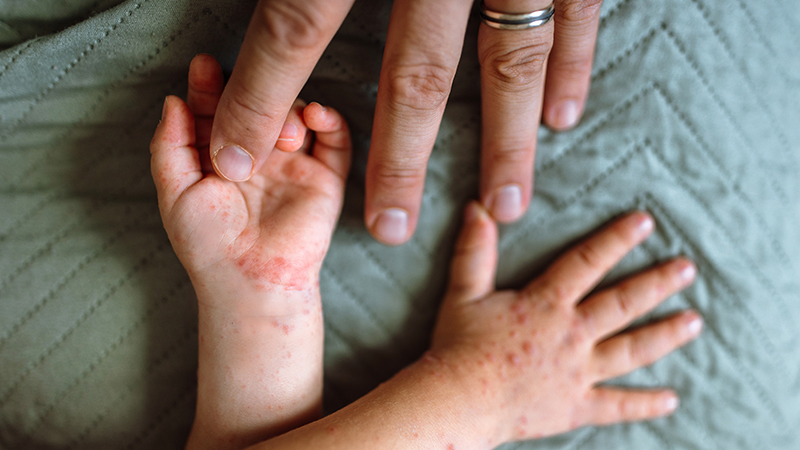The Ultimate Baby Poop Guide: What’s Normal and What’s Not
Understanding Color, Texture, Frequency and Smells
Updated November 2025
If you're a new parent, you might be surprised by how much time you spend thinking about your baby’s poop. It may seem strange, but your baby’s bowel movements can tell you a lot about their health.
This baby poop guide will help you understand what’s normal, what’s not and when it’s time to call your baby’s pediatrician.
Stool frequency can vary from baby to baby.— Anita Chandra-Puri, MD
Normal Baby Poop Appearance
In the first few days of life, your baby will pass black or dark green tarry poop called meconium. It’s thick and sticky and shows that your baby’s digestive system is working. After that, poop changes depending on how your baby is fed.
- Breastfed babies’ poop is usually a mustard yellow, soft and seedy.
- Formula-fed babies’ poop is thicker, like peanut butter, and may be tan or brown.
Both are normal. As babies grow and are introduced to solid foods (typically beginning between four and six months), their poop becomes firmer and has a stronger smell.
“All poop and gas can smell regardless of whether a baby is formula-fed or breastfed,” says Anita Chandra-Puri, MD, a pediatrician at Northwestern Medicine.
What Colors Are Normal?
Outside of brown, your baby’s poop can appear in a variety of colors. Here’s what the color of your baby’s poop means.
- Yellow-brown, orange and green tints are usually fine.
- Green baby poop can happen when they’re teething or if your baby gets more foremilk than hindmilk when breastfeeding. Foremilk is the thinner, more watery milk present at the beginning of a feeding session. It quenches a baby’s thirst. Hindmilk is higher in fat and follows the foremilk toward the end of a feeding session. It provides a sense of fullness. If breastfeeding, both are important for a baby’s health.
- White baby poop or chalky gray may mean your baby isn’t digesting food properly. It could also be a sign of liver problems.
- Red or black poop after the first few days may mean bleeding.
When Is Baby Poop a Problem?
Call your pediatrician if you notice:
- Blood or mucus in the stool, which may present as red or black poop
- White poop
- Red jelly-like poop
- Poop that smells unusually bad, fishy or metallic
- No poop for seven days or more, especially if your baby seems uncomfortable or has a lack of appetite
- One of these symptoms, plus diarrhea and a fever
These could be a sign that your baby has an allergy, infection or digestive issue, so it’s important your baby is seen by a physician.
“A singular change in stool is rarely an emergency,” says Dr. Chandra-Puri. “Wait and see what the next stool is like. If you see the issue more than once, then it’s more of a concern. An issue like an intolerance to a specific food is not going to disappear. It will keep happening.”
How Feeding Affects Poop
Breast milk is easier to digest, so breastfed babies poop more frequently and their poop is softer.
“If a baby is solely breastfed, their stool can be as watery as urine,” says Dr. Chandra-Puri.
Formula-fed infants may poop less often and have firmer stools than breastfed babies. Switching formulas or starting solids can change the color, texture and frequency of poop.
Can a Breastfeeding Parent’s Diet Affect Poop?
If you are breastfeeding, foods containing dairy or caffeine, certain gas-producing vegetables (like broccoli and cabbage), and spicy foods can pass into breast milk and affect your baby’s digestion. This might cause gas, diarrhea or changes in their poop color.
Constipation in Babies
Constipation is when the poop is hard and dry, or your baby strains or goes several days without pooping.
Constipation can be caused by:
- Dehydration from not enough fluid
- Not enough fiber
- Formula issues
- Too much milk
It’s normal for babies to grunt, turn red or strain when pooping.
“They can sometimes strain with a soft poop lying down because they are generating abdominal pressure,” says Dr. Chandra-Puri.
But if your baby cries or strains for more than 10 minutes without success, they may be constipated.
You can try these home remedies for constipation:
- Giving a little water or prune or pear juice if your baby is older than two months
- Doing bicycle leg exercises (laying your baby on their back, taking a leg in each hand and gently moving their legs in a cycling motion)
- A warm bath
- Massaging your baby’s belly in a circular motion
- Offering high-fiber foods like peaches, peas, prunes or oatmeal if they are older than four to six months and eat solid food
Diarrhea in Babies
Diarrhea is watery poop that happens often, usually with stomach pain. It can be caused by viruses, food allergies or antibiotics. Diarrhea can lead to dehydration, so watch for fewer wet diapers, dry mouth and sleepiness.
How to Track and Report Poop Changes
Keep a simple chart (on paper or your phone) that tracks:
- Color
- Texture
- Frequency
- Smell
Note any changes after switching formula or introducing new foods. Take photos or save a diaper (place in a sealed bag) if you’re going to the pediatrician. It helps them see what’s going on.
“Everyone from three days old through adults should urinate a minimum of three times a day, but stool frequency can vary from baby to baby, just like number of feedings per day can vary from baby to baby,” says Dr. Chandra-Puri.
Baby Poop in the 1st Year
Your baby’s poop will change during their first year of life. Here’s an overview of what to expect.
- First days: Dark green or black meconium
- One to six weeks: Soft, frequent poop (yellow or brown), up to eight times a day or as often as their feedings
- Two to six months: Less frequent, more formed
- After introducing solids: Firmer, smells stronger and more variety in color
How to Support Healthy Digestion in Your Baby
Here are a few things you can do to help your baby.
- Stick to a regular feeding schedule.
- Keep your baby hydrated.
- Introduce solids slowly (one new food at a time and noting how they respond to each new food).
- Watch for signs of discomfort.






